The Year in Pictures -- Spring into Summer, part two
...
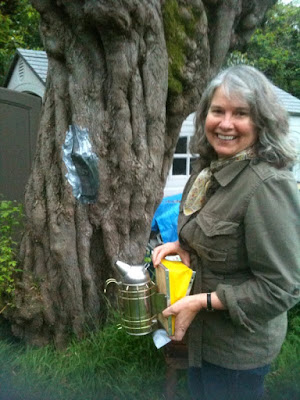
In late March of last year, I helped my friend and coworker Kitty dissuade some bees from making a home in one of her trees. Kitty and her husband were about to embark on some serious construction at their home, and didn't want to have honeybees bothering their contractors. I rigged up a one-way bee-door on the hollow tree that the bees were investigating, and the bees took the hint and found another place to live.
We had some idea that the bees that were checking out potential homes in her back yard might be lured into the hive that Robb had given me for Christmas. I set the hive out in Kitty's back yard.

And about a week later, I took it back, because I had the opportunity to catch a swarm of wild honeybees. (That's me on the right.)
A member of the local beekeeping club had been observing a wild hive that lived in a hollow telephone pole near his home. When it threw off a swarm, he caught that swarm and gave the bees a home. When it threw off five more swarms, he contacted local beekeeper (and wanna-bees, like me) and invited them to catch bees.
This was thrilling, and a bit insane. I could not believe how exciting it was to catch thousands of bees, and then stick them in the back of my station wagon and drive them home.
I was hooked.
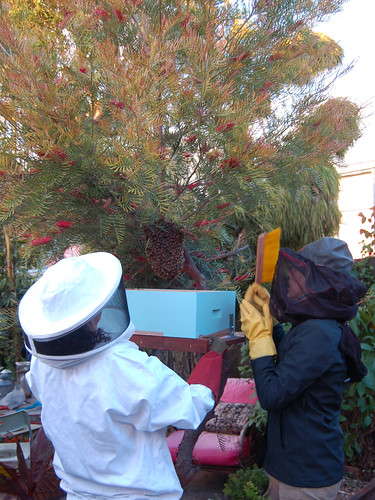
A week after that, I had the chance to catch another swarm. (I'm the one on the left, staying the hell out of the way.)
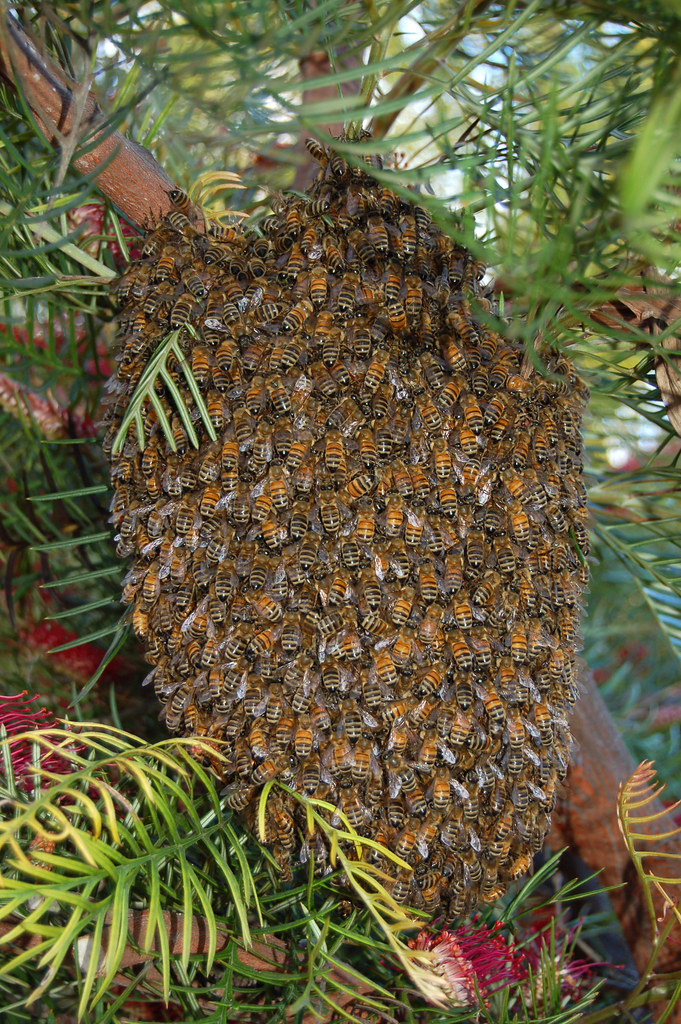
In case you've ever wondered what a swarm of honeybees looks like, it's a very organized structure. The colony decides to divide itself, as a reproductive strategy. The queen and a huge number of bees leave their home and all their resources behind and go looking for a new place to live. The bulk of the bees cluster around protecting the queen. And the bees that I like to think of as "real estate agent bees" go exploring. (Robb gave me a fascinating book that examines the bees' process of deciding which of the potential home sites is selected. The colony is not "ruled" by the queen, but arrives at a choice of home by consensus.)

And a week after that, our friend Taylor gave us the bees that she had been raising from her colony.
We were awash in bees.
We combined Taylor's bees with the two feral swarms, and hoped for the best.

Learning about our bees was one of the summer's great pleasures.
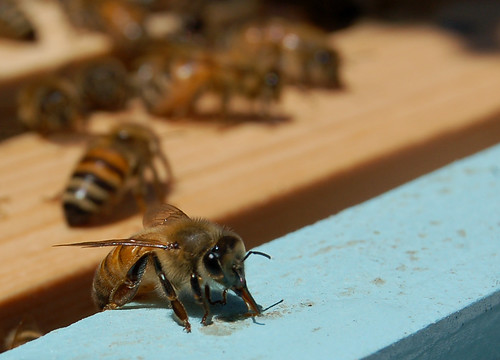
And let's face it, honeybees are pretty darn cute. How many people get to see a bee's tongue?

I found the reproduction in the brood-nest very interesting, as well. In this photo, the bees are tending developing larvae, which look like ivory colored grubs. Bees are incredibly clean creatures, which is good. I was worried that I'd be squeamish about the larvae and pupae.
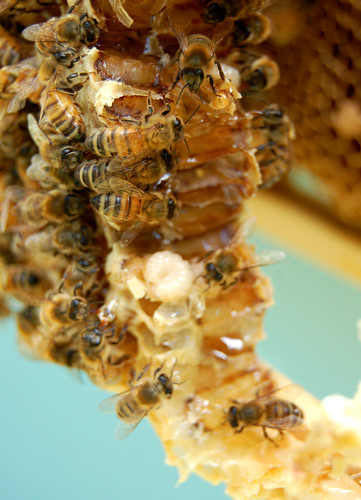
I won't lie. Accidentally ripping brood-comb, and exposing developing bees, was a bit disturbing. Not because the creatures were intrinsically unpleasant, but because our own clumsiness had killed developing bees.

But if we did damage developing bees, we took a moment to learn from what we'd done. This was a pupal bee that was in some comb that ripped loose during a hive inspection. It was pretty freaky, but also fascinating.

Most hive inspections were not filled with carnage. In fact, we got to see baby bees emerging into the world.

We learned a lot about the various wax structures that the bees build. Our bees were very keen on building "queen cups" which initially worried us. Our early reading convinced us that our bees were about to raise more queen, and swarm. We thought that the bees were unhappy with their queen, and wanted to replace her.
We later concluded that bees have the ability to plan ahead, and were building these structures in case they needed to raise new queens in a hurry. Foresight in insects? Amazing.

We also dealt with some pretty disgusting bee diseases. Honey bees in America are afflicted with parasitic mites, that are vectors for all sorts of illnesses. Our bees clearly had Deformed Wing Virus, which we treated with formic acid.
Robb and I wanted to take an "organic as possible" approach to beekeeping, and the formic acid was as benign a treatment as we could find. Perhaps you've seen a nature documentary where songbirds are rolling around in anthills. Ants produce formic acid when disturbed, which is a natural miticide. Songbirds also suffer from parasitic mites, and some have learned to exploit the ants' ability to produce this chemical.

Even with mites present in the hives, our bees were incredibly vigorous.
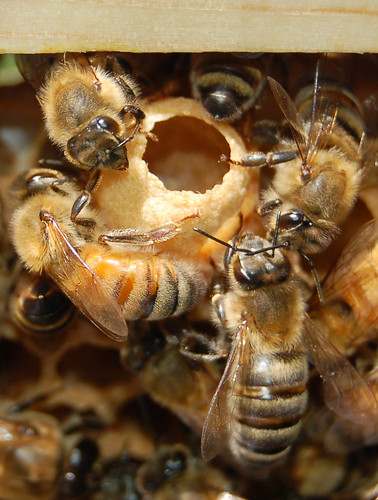
Yes, beekeeping was a great addition to our lives.
The Bees

In late March of last year, I helped my friend and coworker Kitty dissuade some bees from making a home in one of her trees. Kitty and her husband were about to embark on some serious construction at their home, and didn't want to have honeybees bothering their contractors. I rigged up a one-way bee-door on the hollow tree that the bees were investigating, and the bees took the hint and found another place to live.
We had some idea that the bees that were checking out potential homes in her back yard might be lured into the hive that Robb had given me for Christmas. I set the hive out in Kitty's back yard.

And about a week later, I took it back, because I had the opportunity to catch a swarm of wild honeybees. (That's me on the right.)
A member of the local beekeeping club had been observing a wild hive that lived in a hollow telephone pole near his home. When it threw off a swarm, he caught that swarm and gave the bees a home. When it threw off five more swarms, he contacted local beekeeper (and wanna-bees, like me) and invited them to catch bees.
This was thrilling, and a bit insane. I could not believe how exciting it was to catch thousands of bees, and then stick them in the back of my station wagon and drive them home.
I was hooked.

A week after that, I had the chance to catch another swarm. (I'm the one on the left, staying the hell out of the way.)

In case you've ever wondered what a swarm of honeybees looks like, it's a very organized structure. The colony decides to divide itself, as a reproductive strategy. The queen and a huge number of bees leave their home and all their resources behind and go looking for a new place to live. The bulk of the bees cluster around protecting the queen. And the bees that I like to think of as "real estate agent bees" go exploring. (Robb gave me a fascinating book that examines the bees' process of deciding which of the potential home sites is selected. The colony is not "ruled" by the queen, but arrives at a choice of home by consensus.)

And a week after that, our friend Taylor gave us the bees that she had been raising from her colony.
We were awash in bees.
We combined Taylor's bees with the two feral swarms, and hoped for the best.

Learning about our bees was one of the summer's great pleasures.

And let's face it, honeybees are pretty darn cute. How many people get to see a bee's tongue?

I found the reproduction in the brood-nest very interesting, as well. In this photo, the bees are tending developing larvae, which look like ivory colored grubs. Bees are incredibly clean creatures, which is good. I was worried that I'd be squeamish about the larvae and pupae.

I won't lie. Accidentally ripping brood-comb, and exposing developing bees, was a bit disturbing. Not because the creatures were intrinsically unpleasant, but because our own clumsiness had killed developing bees.

But if we did damage developing bees, we took a moment to learn from what we'd done. This was a pupal bee that was in some comb that ripped loose during a hive inspection. It was pretty freaky, but also fascinating.

Most hive inspections were not filled with carnage. In fact, we got to see baby bees emerging into the world.

We learned a lot about the various wax structures that the bees build. Our bees were very keen on building "queen cups" which initially worried us. Our early reading convinced us that our bees were about to raise more queen, and swarm. We thought that the bees were unhappy with their queen, and wanted to replace her.
We later concluded that bees have the ability to plan ahead, and were building these structures in case they needed to raise new queens in a hurry. Foresight in insects? Amazing.

We also dealt with some pretty disgusting bee diseases. Honey bees in America are afflicted with parasitic mites, that are vectors for all sorts of illnesses. Our bees clearly had Deformed Wing Virus, which we treated with formic acid.
Robb and I wanted to take an "organic as possible" approach to beekeeping, and the formic acid was as benign a treatment as we could find. Perhaps you've seen a nature documentary where songbirds are rolling around in anthills. Ants produce formic acid when disturbed, which is a natural miticide. Songbirds also suffer from parasitic mites, and some have learned to exploit the ants' ability to produce this chemical.

Even with mites present in the hives, our bees were incredibly vigorous.

Yes, beekeeping was a great addition to our lives.

Comments
I really enjoy how you explore all parts of the bees lives. it's really fascinating animals:)